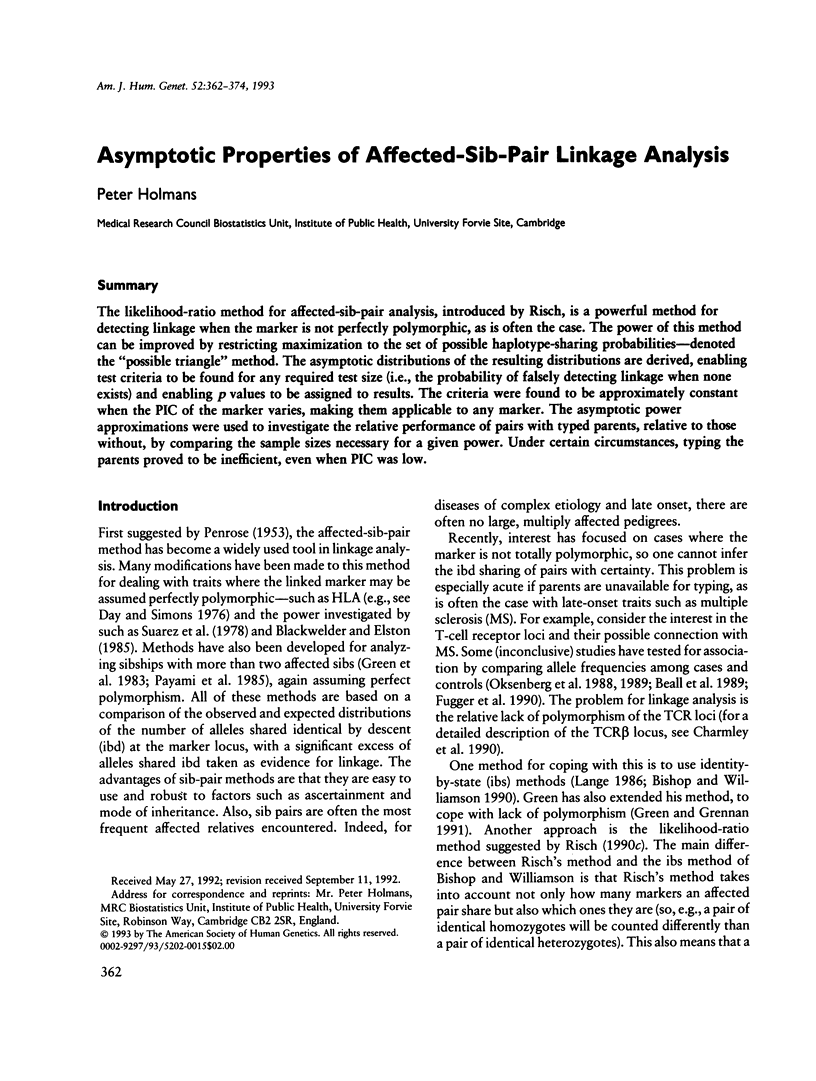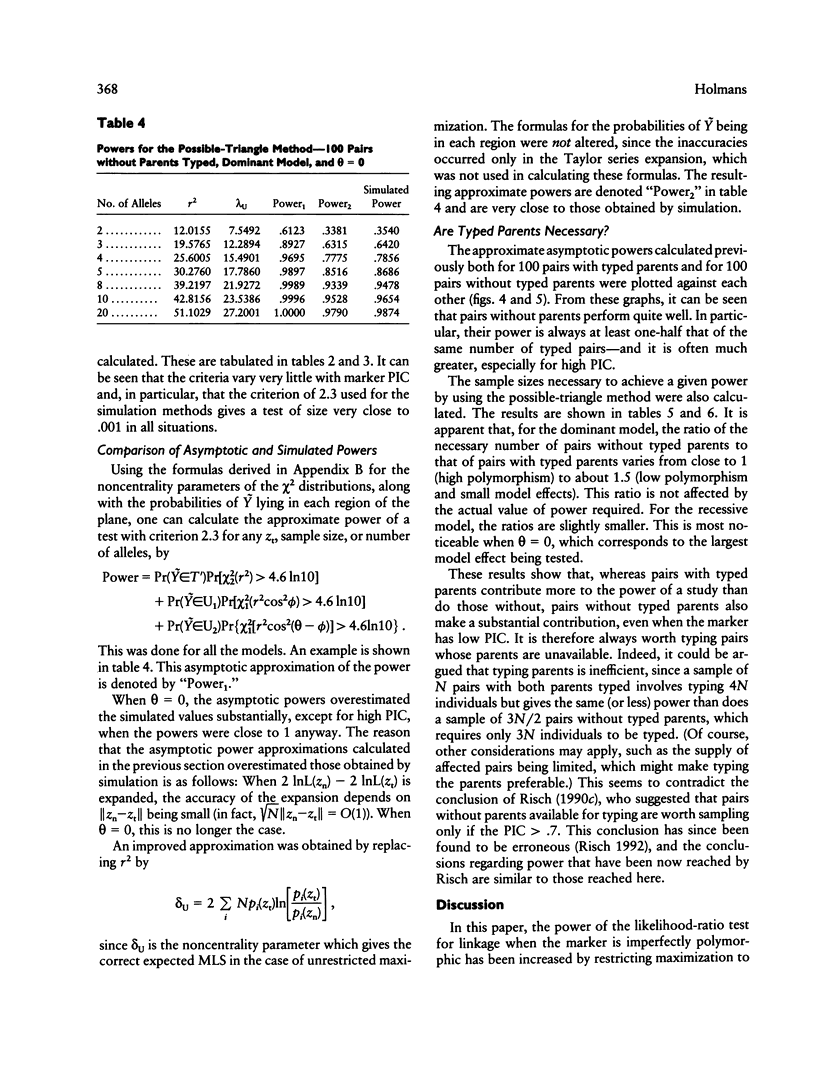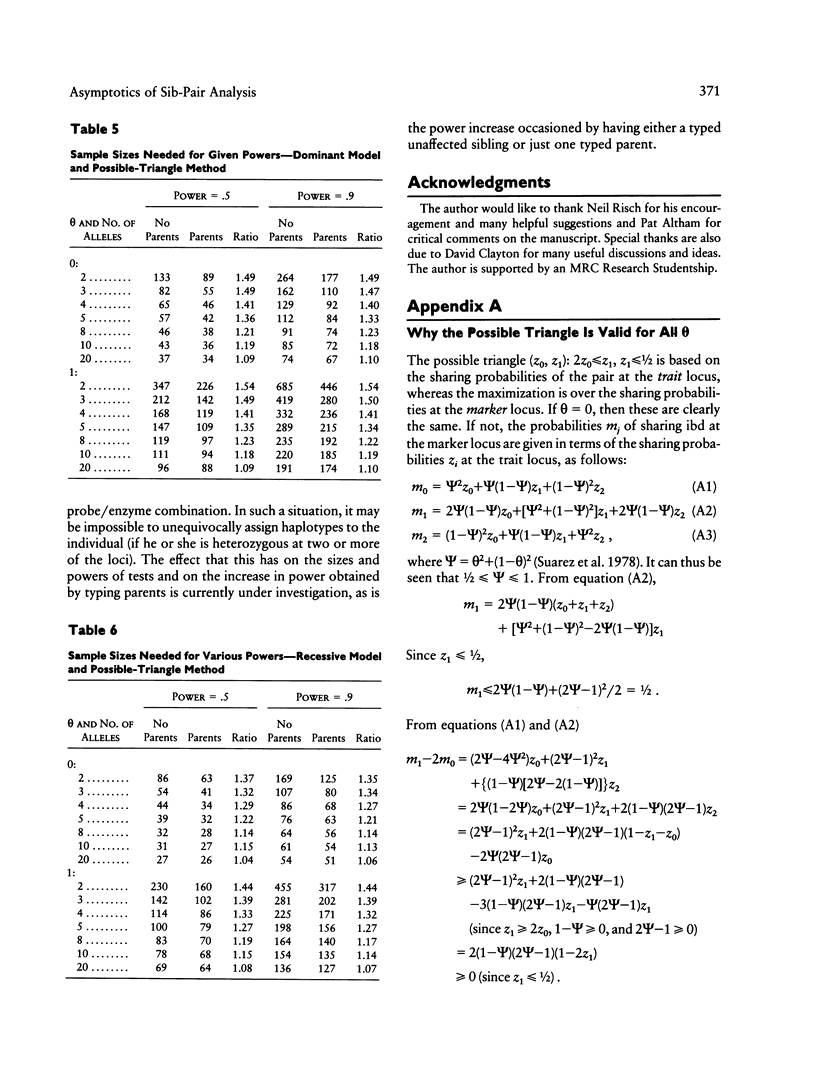Abstract
The likelihood-ratio method for affected-sib-pair analysis, introduced by Risch, is a powerful method for detecting linkage when the marker is not perfectly polymorphic, as is often the case. The power of this method can be improved by restricting maximization to the set of possible haplotype-sharing probabilities--denoted the "possible triangle" method. The asymptotic distributions of the resulting distributions are derived, enabling test criteria to be found for any required test size (i.e., the probability of falsely detecting linkage when none exists) and enabling p values to be assigned to results. The criteria were found to be approximately constant when the PIC of the marker varies, making them applicable to any marker. The asymptotic power approximations were used to investigate the relative performance of pairs with typed parents, relative to those without, by comparing the sample sizes necessary for a given power. Under certain circumstances, typing the parents proved to be inefficient, even when PIC was low.
Full text
PDF












Selected References
These references are in PubMed. This may not be the complete list of references from this article.
- Bishop D. T., Williamson J. A. The power of identity-by-state methods for linkage analysis. Am J Hum Genet. 1990 Feb;46(2):254–265. [PMC free article] [PubMed] [Google Scholar]
- Blackwelder W. C., Elston R. C. A comparison of sib-pair linkage tests for disease susceptibility loci. Genet Epidemiol. 1985;2(1):85–97. doi: 10.1002/gepi.1370020109. [DOI] [PubMed] [Google Scholar]
- Botstein D., White R. L., Skolnick M., Davis R. W. Construction of a genetic linkage map in man using restriction fragment length polymorphisms. Am J Hum Genet. 1980 May;32(3):314–331. [PMC free article] [PubMed] [Google Scholar]
- Charmley P., Chao A., Concannon P., Hood L., Gatti R. A. Haplotyping the human T-cell receptor beta-chain gene complex by use of restriction fragment length polymorphisms. Proc Natl Acad Sci U S A. 1990 Jun;87(12):4823–4827. doi: 10.1073/pnas.87.12.4823. [DOI] [PMC free article] [PubMed] [Google Scholar]
- Day N. E., Simons M. J. Disease susceptibility genes--their identification by multiple case family studies. Tissue Antigens. 1976 Aug;8(2):109–119. [PubMed] [Google Scholar]
- Fugger L., Sandberg-Wollheim M., Morling N., Ryder L. P., Svejgaard A. The germline repertoire of T-cell receptor beta chain genes in patients with relapsing/remitting multiple sclerosis or optic neuritis. Immunogenetics. 1990;31(4):278–280. doi: 10.1007/BF00204901. [DOI] [PubMed] [Google Scholar]
- Green J. R., Grennan D. M. Testing for haplotype sharing by siblings with incomplete information of parental haplotypes. Ann Hum Genet. 1991 Jul;55(Pt 3):243–249. doi: 10.1111/j.1469-1809.1991.tb00419.x. [DOI] [PubMed] [Google Scholar]
- Green J. R., Low H. C., Woodrow J. C. Inference on inheritance of disease using repetitions of HLA haplotypes in affected siblings. Ann Hum Genet. 1983 Jan;47(Pt 1):73–82. doi: 10.1111/j.1469-1809.1983.tb00972.x. [DOI] [PubMed] [Google Scholar]
- James J. W. Frequency in relatives for an all-or-none trait. Ann Hum Genet. 1971 Jul;35(1):47–49. doi: 10.1111/j.1469-1809.1956.tb01377.x. [DOI] [PubMed] [Google Scholar]
- Lange K. The affected sib-pair method using identity by state relations. Am J Hum Genet. 1986 Jul;39(1):148–150. [PMC free article] [PubMed] [Google Scholar]
- Oksenberg J. R., Gaiser C. N., Cavalli-Sforza L. L., Steinman L. Polymorphic markers of human T-cell receptor alpha and beta genes. Family studies and comparison of frequencies in healthy individuals and patients with multiple sclerosis and myasthenia gravis. Hum Immunol. 1988 Jun;22(2):111–121. doi: 10.1016/0198-8859(88)90041-9. [DOI] [PubMed] [Google Scholar]
- Oksenberg J. R., Sherritt M., Begovich A. B., Erlich H. A., Bernard C. C., Cavalli-Sforza L. L., Steinman L. T-cell receptor V alpha and C alpha alleles associated with multiple and myasthenia gravis. Proc Natl Acad Sci U S A. 1989 Feb;86(3):988–992. doi: 10.1073/pnas.86.3.988. [DOI] [PMC free article] [PubMed] [Google Scholar]
- PENROSE L. S. The general purpose sibpair linkage test. Ann Eugen. 1953 Sep;18(2):120–124. [PubMed] [Google Scholar]
- Payami H., Thomson G., Motro U., Louis E. J., Hudes E. The affected sib method. IV. Sib trios. Ann Hum Genet. 1985 Oct;49(Pt 4):303–314. doi: 10.1111/j.1469-1809.1985.tb01706.x. [DOI] [PubMed] [Google Scholar]
- Risch N. Linkage strategies for genetically complex traits. I. Multilocus models. Am J Hum Genet. 1990 Feb;46(2):222–228. [PMC free article] [PubMed] [Google Scholar]
- Spielman R. S., Nathanson N. The genetics of susceptibility to multiple sclerosis. Epidemiol Rev. 1982;4:45–65. doi: 10.1093/oxfordjournals.epirev.a036251. [DOI] [PubMed] [Google Scholar]
- Suarez B. K., Rice J., Reich T. The generalized sib pair IBD distribution: its use in the detection of linkage. Ann Hum Genet. 1978 Jul;42(1):87–94. doi: 10.1111/j.1469-1809.1978.tb00933.x. [DOI] [PubMed] [Google Scholar]


